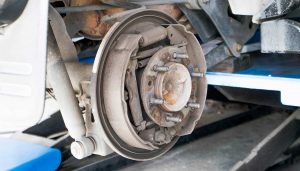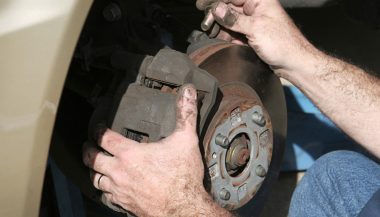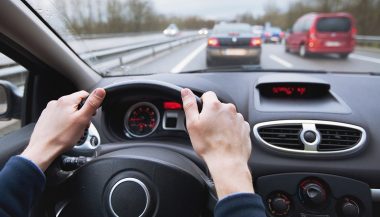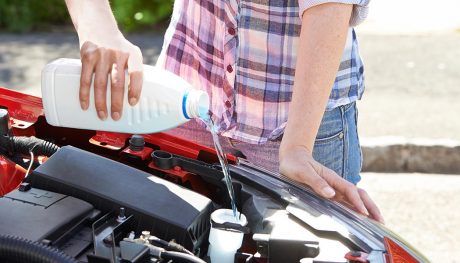
A Mechanic's Guide On How To Bleed Brakes
Brake Lines Giving You Issues? Try Bleeding Them Out
Are your brakes dipping closer to the carpet than they should? Do they feel spongy? If you inspect the brake pads and they appear to be in decent shape, the “spongy” feeling is most likely caused by air in the brake line. The good news is, learning how to bleed brakes is easy. You can fix the problem with a box wrench, a turkey baster, a plastic soda bottle, some tubing, and an assistant who is tall enough to reach the brake pedal.
That’s the drill for an older car without ABS. A newer car with ABS can get a bit trickier, and it can also be downright expensive. Some models require a very pricey proprietary ABS scan tool to cycle the pump and valves to purge the last of the air, but we’ll get to that in a minute. First, let’s look at what exactly is causing your car issues. Then, we’ll go over how to bleed brakes.
How Does Air Enter the Brake Line in the First Place?
In its simplest form, your brakes are a hydraulic system. When you press on the pedal you are pressing on a “solid” column of brake fluid which in turn causes the calipers to press the pads against the discs. Air is “compressible.” When even a bubble or two enters the brake line, it’s like installing a soft spring in that solid column of brake fluid. That’s what gives you the spongy feeling, and that’s what degrades the efficiency of your brake system. When this happens, your confidence in your car’s ability to brake might be a bit shaky.
So, how does that air get in the line?
Well, there are a number of different ways. DOT brake fluid only has a life span of roughly three years. It has an affinity for moisture. When moisture enters the line it reduces the boiling point of the fluid and can cause boiling. This is particularly true if you do a lot of hard braking or travel long, downhill grades on a regular basis. Boiling causes stream, and part of that steam will turn into air when it condenses.
Changing brake parts like calipers will also allow air in the line.
Worn brake pads are a common cause. When the pads get thin the “solid column” has to reach further to apply the pressure being applied from the pedal. That means the column needs to be marginally longer, which in turn means it needs more fluid. That fluid comes from the master cylinder reservoir.
If the level of fluid in the master cylinder gets too low, an air bubble can find its way into the line. That single “soft spring” can cause the fluid level in the reservoir to drop even lower when the pedal is applied, which increases the chance of more air bubbles entering.
If you have ABS, air (and other contaminants) in the line becomes an even bigger problem. Unlike the “solid column” system, ABS has a hydraulic pump. That pump operates at several thousand psi, forcing brake fluid through very small valves. Toss in an air bubble at that pressure and you can froth up the fluid like milk for a cappuccino.
The fix? Bleed the air from the system and put in fresh, clean brake fluid. Oh, and replace those worn pads while you are at it.
How to Bleed Brakes for Non-ABS Systems
Time for a quick overview on how to bleed brakes for a non-ABS system! We are going to bleed the air from each of the four lines one at a time. By necessity, we will be replacing the brake fluid with new fluid that should last 2—3 years. This method has us draining the longest line first, and the shortest line last. Most master cylinders are located on the driver’s-side of the engine compartment. That means the longest line runs to the passenger-side rear brake. After that comes the driver-side rear, then the passenger-side front, and finally, the driver-side front.
To start, you’ll need a couple cans of brake fluid, a box wrench that fits the bleeder valves, clear tubing to drain the fluid, and a some sort of bottle to collect the fluid in. You’ll also want a turkey baster or syringe to help drain the reservoir. And, of course, you’ll need an assistant, and trust us, anyone who can reach the brake pedal will do.
If you have enough clearance you may be able to reach the bleeder valves without jacking up the car. If not, you’ll have to get the car up on stands. Before you do that though, you want to use the turkey baster to suck out the fluid from the master cylinder reservoir. Use a lint free cloth to wipe out the inside of the reservoir, and then refill it with new fluid.
Now we’re ready to start:
- Locate the bleeder valves and open them about a quarter turn. This might be the most difficult part of the whole process as these can be difficult to crack. If they don’t want to turn, try some WD-40. Do not break the valve off. That is a professional repair job. When you can crack it a quarter turn, gently close the valve. Do this on all four lines.
- Starting with the right rear brake (the longest line) place the clear tubing over the bleeder valve. Put the end of the tube in the soda bottle and then add enough brake fluid to cover the end. This prevents air from being sucked back into the line as you are bleeding it.
- When you have your tube installed, ask your assistant to start pumping the pedal until it feels “solid,” and then hold. When they get to that point, have them yell “hold.” That’s your cue to open the bleeder valve and let the fluid drain into the bottle. If there is air in the line you’ll see bubbles in the tube. When the pressure drops, pinch off the line and yell “up” to your assistant. This is their cue to pump until they get that solid feeling again, and then yell “solid.” You go through this routine until the fluid stops running altogether. At that point, close the bleeder valve.
- Check the master cylinder reservoir and replace the fluid you just pumped out with fresh brake fluid. Don’t let this reservoir go dry or you’ll have to go through the whole process again.
- That’s one down, and three more to go! Just follow the rotation schedule set out earlier and do the same routine for each line. Remember to top off the master cylinder reservoir as you go.
- When you are done, take the car out for a spin. The brakes may still feel soft for a short while but should firm up in less than a mile. When you return, check the master cylinder reservoir and top it off if necessary.
- One final thing: you now have a bottle full of old brake fluid. Make sure you dispose of it responsibly. It does not go down the storm drain or your toilet. Many parts stores will take it, or you can bring it to your nearest hazardous waste center.
These instructions will work if you have an older car that is not equipped with ABS. However, if you do have ABS you’ll have a slightly different method to use.
How to Bleed Brakes for an ABS System
For starters, air in the ABS modulator is pretty rare. The only way air can get into the unit is from “upstream.” Air entering from “downstream,” like when replacing brake parts, cannot enter the modulator. That said, it’s still a good idea to “bleed” the ABS to get new fluid.
Here’s a little clue: it isn’t easy.
The modulator is a pump that forces the fluid through 8—10 valves. There are about a half dozen systems, and each has its own process. For the best results you should check the manufacturer’s instructions. Several have no bleeder valves, and bleeding is accomplished by cycling the valves in the pump. Unfortunately, in order to do that, you will need a special modulator scan tool.
The scan essentially sends an electronic command to the modulator to perform a cycling routine. If you don’t have a scan it may be a better idea to have the bleeding done by a pro. Otherwise, expect to spend between $100—$300 to buy the tool. Some parts stores offer the scanner as a rental, which might be a viable alternative; it never hurts to ask about this option.
There is a way to force a cycling, although it is not a responsible method. Find a stretch of road where you can perform a few high speed, ABS-initiating stops. Presto, the modulator has recycled.
Assuming you have either the tool, or you have employed other means to cycle the modulator, you can then bleed the lines at the wheels. However, the sequence of bleeding may vary with an ABS system. You still want to bleed the longest line first, but with ABS the distance is measured from the modulator, not the master cylinder.
Modulators can be mounted in the engine compartment, dead center of the vehicle. Sometimes, one is even mounted in the rear. Make sure you identify the location, and then determine your sequence for valve bleeding.
When in Doubt, Bleed it Out
Few things will generate anxiety faster than discovering you can’t stop your car as you approach a red light. Now that you know how to bleed brakes, do it as soon as you detect an issue in the pedal. What’s it cost you? A couple of cans of brake fluid and 15–20 minutes of your time? That’s better than risking the chance of not coming to a full stop at an intersection. You can even get brake fluid online these days.
We don’t want this to sound like it is something you have to do every year. In fact, some new cars are designed so that you will never have to bleed the brake lines. But if you are in an older ride, a change of fluid every three years should prevent air from finding its way into the system.
Having Brakes Bled Professionally
If you don’t have car stands or at least four cinder blocks, and the whole idea of squirting fluid in a bottle stresses you out, the alternative option is taking your car to a service shop. This does not automatically make you a DIY failure. In fact, there are a number of good reasons for using a professional for this comparatively low-skill task. Here are some scenarios for when you should have a professional bleed your brakes:
- If you have ABS. As mentioned earlier, bleeding brakes becomes complicated if you have ABS. To do it at home you need an expensive scanner to recycle the modulator, or you have to leave a trail of rubber from a high-speed stop that triggers the ABS. Not surprisingly, the service shop will have that expensive scanner. Not only do you replace all the brake fluid, but you don’t have to take a year off the tread life on your car.
- Frozen bleeder valves. If you have an older car and you have never bled the brakes, odds are the bleeder valves will be frozen. To loosen them up you’ll need to spray copious amounts of WD-40, and then tap them with a small hammer. Bleeder valves are easy to snap off if you put too much torque in your effort to open them. If that happens, the cost of bleeding the brake line will be chump change compared to the cost of the repair. If someone is going to snap off the vales, let it be someone who works at the shop.
- It’s not that expensive. Of course, it depends on where you live, but RepairPal.com estimates the cost at $61—$128 plus tax and disposal fee (for the old fluid) to bleed your brakes. As maintenance costs go, that’s not much. It certainly is not as expensive as buying a scanner tool.
If you use a professional to bleed your brakes, there’s no law that says you have to tell your gearhead buddies. Walk tall, and brake with authority.





